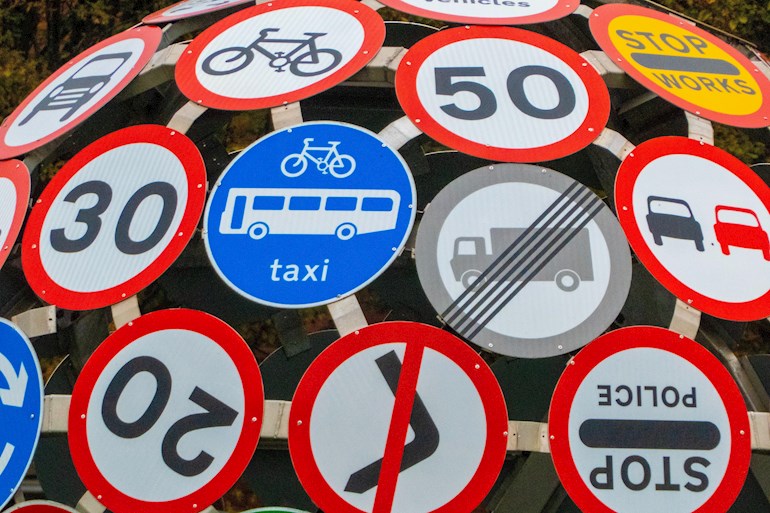Photo by Nick Fewings on Unsplash
The Highway code is set to change on the 29th January 2022 with new rules being introduced as well as updates to existing rules.
Among the changes is a new ‘Hierarchy of road users’ that will prioritise vulnerable road users, such as cyclists and pedestrians
This post is to highlight the changes that relate to pedestrians and therefore runners.
The main areas of change are:-
* New Hierarchy of Road Users to be introduced.
* More responsibility on drivers of larger vehicles.
* Pedestrians given higher priority.
* New rules H1, H2 and H3
Rules H1 and H2 specifically relate to pedestrians.
Rule H1: Hierarchy of road users
The first (and most significant) rule in the refreshed Highway Code sets out the hierarchy of road users. Road users who can do the greatest harm (those driving large vehicles) have the greatest responsibility to reduce the danger they pose to other road users. Pedestrians (children, older adults and disabled people in particular) are identified as ‘the most likely to be injured in the event of a collision’. Here’s a look at what the hierarchy of road users looks like:
1. Pedestrians
2. Cyclists
3. Horse riders
4. Motorcyclists
5. Cars/taxi’s
6. Vans/minibuses
7. Large passenger vehicles/heavy goods vehicles
As can be seen, cyclists and horse riders will also have a responsibility to reduce danger to pedestrians. Even so, the updated The Highway Code emphasises that pedestrians themselves still need to consider the safety of other road users.
Rule H2: Clearer and stronger priorities for pedestrians
This rule is aimed at drivers, motorists, horse riders and cyclists. The Highway Code now states clearly that, at a junction, you should give way to pedestrians crossing or waiting to cross a road that you’re turning into. Previously, vehicles had priority at a junction. Drivers should also give way to pedestrians waiting to cross a zebra crossing, and pedestrians and cyclists waiting to cross a parallel crossing (a combined pedestrian and cycle crossing). Meanwhile, cyclists should give way to pedestrians on shared-use cycle tracks, and are reminded that only pedestrians (including those using wheelchairs and mobility scooters) can use the pavement. Pedestrians are allowed to use cycle tracks unless there’s a road sign nearby that says doing so is prohibited.
Rule H3: drivers to give priority to cyclists in certain situations
This rule is not specifically related to pedestrians so will not be covered in this post.
As well as the above changes it is worth including here a reminder of existing rules that apply to pedestrians and therefore runners.
General guidance (Rules 1 to 6)
Rule 1
Pavements (including any path along the side of a road) should be used if provided. Where possible, avoid being next to the kerb with your back to the traffic. If you have to step into the road, look both ways first. Always show due care and consideration for others.
Rule 2
If there is no pavement, keep to the right-hand side of the road so that you can see oncoming traffic. You should take extra care and
* be prepared to walk in single file, especially on narrow roads or in poor light
* keep close to the side of the road.
It may be safer to cross the road well before a sharp right-hand bend so that oncoming traffic has a better chance of seeing you. Cross back after the bend.
Rule 3
Help other road users to see you. Wear or carry something light-coloured, bright or fluorescent in poor daylight conditions. When it is dark, use reflective materials (eg armbands, sashes, waistcoats, jackets, footwear), which can be seen by drivers using headlights up to three times as far away as non-reflective materials.
Rule 4
Young children should not be out alone on the pavement or road (see rule 7). When taking children out, keep between them and the traffic and hold their hands firmly. Strap very young children into pushchairs or use reins. When pushing a young child in a buggy, do not push the buggy into the road when checking to see if it is clear to cross, particularly from between parked vehicles.
Rule 5
This rule applies to groups of people so would also apply to organised group runs !
Organised walks. Large groups of people walking together should use a pavement if available; if one is not, they should keep to the left. Look-outs should be positioned at the front and back of the group, and they should wear fluorescent clothes in daylight and reflective clothes in the dark. At night, the look-out in front should show a white light and the one at the back a red light. People on the outside of large groups should also carry lights and wear reflective clothing.
Rule 6
Motorways. Pedestrians MUST NOT be on motorways or slip roads except in an emergency (see Rule 271 and Rule 275)
This post is intended as a guide for runners and in no way is a definitive document or substitute for the official guide.
As always, awareness of the surroundings we are running is crucial, and these new rules do not negate our responsibility for our own safety and safety of others.
In a recent poll only 30% of drivers were aware of these changes !
For more detailed information on these changes and other areas of the highway code visit.
gov.uk/browse/driving/highw...
NOTE:
New changes will not show until after 29th Jan 2022
